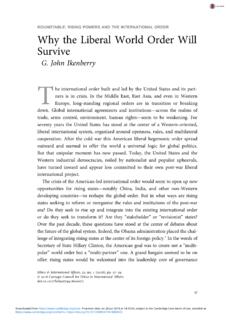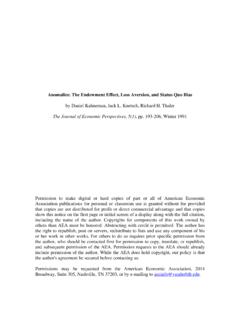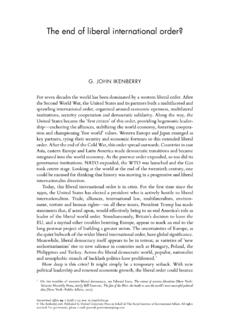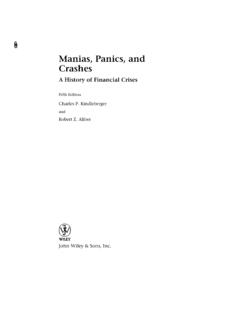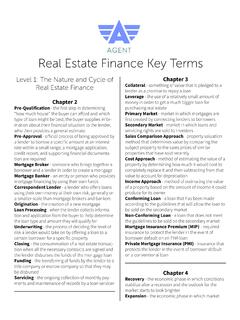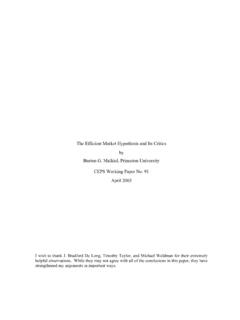Transcription of The I Theory of Money - Princeton University
1 The I Theory of Money . Markus K. Brunnermeier and Yuliy Sannikov . August 8, 2016. Abstract A Theory of Money needs a proper place for financial intermediaries. Intermediaries diversify risks and create inside Money . In downturns, micro-prudent intermediaries shrink their lending activity, fire-sell assets and supply less inside Money , exactly when Money demand rises. The resulting Fisher disinflation hurts intermediaries and other borrowers. Shocks are amplified, volatility spikes and risk premia rise. Monetary policy is redistributive. Accommodative monetary policy that boosts assets held by balance sheet-impaired sectors, recapitalizes them and mitigates the adverse liquidity and disinflationary spirals. Since monetary policy cannot provide insurance and control risk-taking separately, adding macroprudential policy that limits leverage attains higher welfare.
2 Keywords: Monetary Economics, (Inside) Money , Endogenous Risk Dynamics, Volatility Paradox, Paradox of Prudence, Financial Frictions. JEL Codes: E32, E41, E44, E51, E52, E58, G01, G11, G21.. We are grateful to comments by discussants Doug Diamond, Mike Woodford, Marco Bassetto, Itamar Drechsler, Michael Kumhoff, Alexi Savov and seminar participants at various universities and conferences.. Brunnermeier: Department of Economics, Princeton University , Sannikov: De- partment of Economics, Princeton University , 1. 1 Introduction A Theory of Money needs a proper place for financial intermediaries. Financial institutions are able to create Money when they extend loans to businesses and home buyers, they credit the borrowers with deposits and so create inside Money . Money creation by financial intermediaries depends crucially on the health of the banking system and the presence of profitable investment opportunities.
3 This paper proposes a Theory of Money and provides a framework for analyzing the interaction between price stability and financial stability. It therefore provides a unified way of thinking about monetary and macroprudential policy. We model Money supply and demand, and the role of financial intermediaries as follows. Households manage productive projects that use capital and expose them to idiosyncratic risk. They hold Money for self insurance against this risk. This creates Money demand - as in Samuelson (1958) and Bewley (1980) Money has value in equilibrium even though it never pays dividends - in other words Money is a bubble. Money supply consists of outside Money and inside Money created by intermediaries. Intermediaries take stakes in the households' risky projects, absorbing and diversifying some of households' risk. They are active in maturity and liquidity transformation, as they issue liquid, at notice redeemable, (inside) Money and invest in illiquid long-term assets.
4 The mismatch between assets and liabilities exposes intermediaries to risk. When intermediaries suffer losses, they shrink their balance sheets, creating less inside Money and financing fewer household projects. In this case Money supply shrinks and Money demand rises. Together, both effects lead to increase in the value of outside Money , disinflation a la Fisher (1933) occurs. The relationship between the value of Money and the state of the financial system can be understood through two polar cases. In one polar case intermediaries are undercapitalized and cannot perform their functions. Without inside Money , Money supply is scarce and the value of Money is high. Households have a desire to hold Money which, unlike the households'. risky projects, is subject only to aggregate, not idiosyncratic, risk. In the opposite polar case, intermediaries are well capitalized and so well equipped to mitigate financial frictions.
5 They are able to exploit the diversification benefits by investing across many different projects. Intermediaries also create inside Money and hence the Money multiplier is high. At the same time, since households can offload some of their idiosyncratic risks to the intermediary sector, their demand for Money is low. Hence, the value of Money is low in this polar case. An adverse shock to end borrowers not only hurts the intermediaries directly, but also moves the economy closer to the first polar regime with high value of Money . Shocks are 2. amplified by spirals on both sides of intermediaries' balance sheets. On the asset side, in- termediaries are exposed to productivity shocks of their end-borrowers. End-borrowers' fire sales depress the price of physical capital and liquidity spirals further erode intermediaries'. net worth (as shown in Brunnermeier and Sannikov (2014)).
6 On the liabilities side, inter- mediaries are hurt by the Fisher disinflation. As lending and inside Money creation shrink, Money demand rises and the real value of nominal liabilities expands. The Paradox of Prudence arises when intermediaries shrink their balance sheet and households tilt their portfolio away from real investment towards the safe asset , Money . Scaling back risky asset holding is micro-prudent, but makes the economy more risky, it is macro-imprudent. Our Paradox of Prudence is in the risk space what Keynes' Paradox of Thrift is for the consumption-savings decision. The Paradox of thrift describes how each person's attempt to save more paradoxically lowers overall aggregate savings. In our model attempts to reduce in- dividual risks increases endogenous risks as the economy's capacity to diversify idiosyncratic risk moves around endogenously.
7 Monetary policy can work against the adverse feedback loops that precipitate crises, by affecting the prices of assets held by constrained agents and redistributing wealth. That is, monetary policy works through wealth/income effects, unlike conventional New Keynesian models in which monetary policy gains traction by changing intertemporal incentives a substitution effect. Specifically, in our model, monetary policy softens the blow of negative shocks and helps the intermediary sector to maintain the capacity to diversify idiosyncratic risk. Thus, it reduces endogenous (self-generated) risk and overall risk premia. Monetary policy is redistributive, but it is not a zero-sum game redistribution can actually improve welfare. Unexpected monetary policy redistributes wealth, but anticipated loosening redis- tributes risk by affecting prices and returns on assets in different states.
8 Thus, monetary policy can provide insurance. Simple interest rate cuts in downturns improve economic outcomes only if they boost prices of assets, such as long-term government bonds, that are held by constrained sectors. Wealth redistribution towards the constrained sector leads to a rise in economic activity and an increase in the price of physical capital. As the constrained intermediary sector recovers, it creates more (inside) Money and reverses the disinflationary pressure. The appreciation of long-term bonds also mitigates Money demand, since long-term bonds are also safe assets and hence can be used as a store of value as well. As banks are recapitalized, they are able to take on more idiosyncratic household risks, so economy-wide diversification of risk improves and the overall economy becomes, somewhat paradoxically, safer. Importantly, monetary 3.
9 Policy also affects risk premia. As interest rate moves affect the equilibrium allocations, they also affect the long-term real interest rate as documented by Hanson and Stein (2014). and term premia and credit spread as documented by Gertler and Karadi (2014). From an ex-ante perspective long-term bonds are a good hedging instrument for intermediaries if the central bank follows an appropriate monetary policy rule. After an adverse shock, central banks cut short-term interest rates and bonds appreciate. Like any insurance, stealth recapitalization of the financial system through monetary policy can potentially create a moral hazard problem. However, moral hazard from monetary policy is less severe than that associated with explicit bailouts of failing institutions. The reason is that monetary policy is a crude redistributive tool that helps the strong institutions more than the weak.
10 The cautious institutions that bought long-term bonds as a hedge against downturns benefit more from interest rate cuts than the opportunistic institutions that increased leverage to take on more risk. In contrast, ex-post bailouts of the weakest institutions create strong risk-taking incentives ex-ante. While monetary policy improves welfare, the right amount of risk redistribution is not always clearcut. It comes with side effects since several quantities adjust endogenously. Monetary policy cannot control risk separately from risk-taking and risk premia. Policy that only partially completes the markets need not be welfare-improving, as originally shown in the famous Hart (1975) example. Monetary policy is just one tool, which cannot perfectly control the many quantities determined by a system of equilibrium equations, moral hazard exists.







